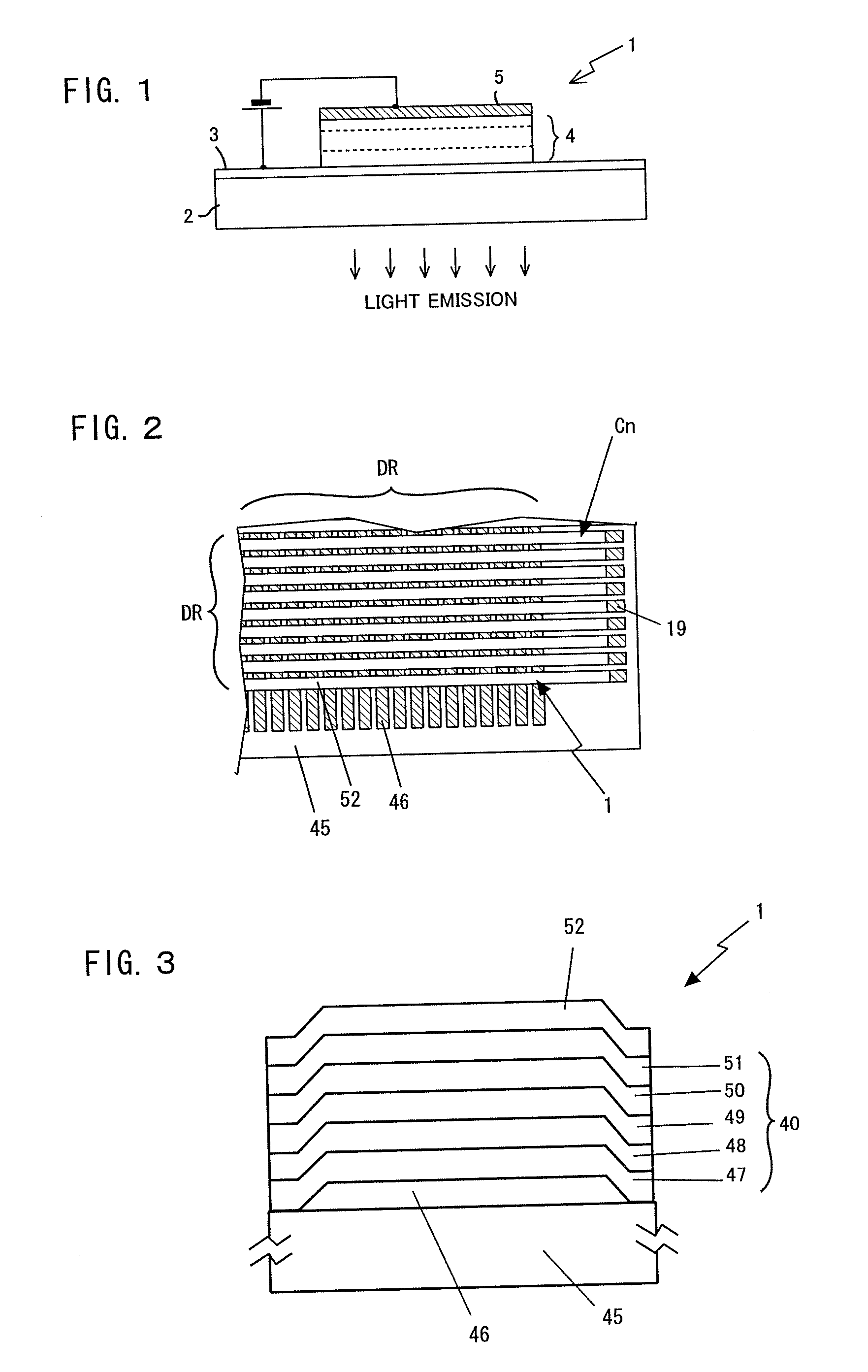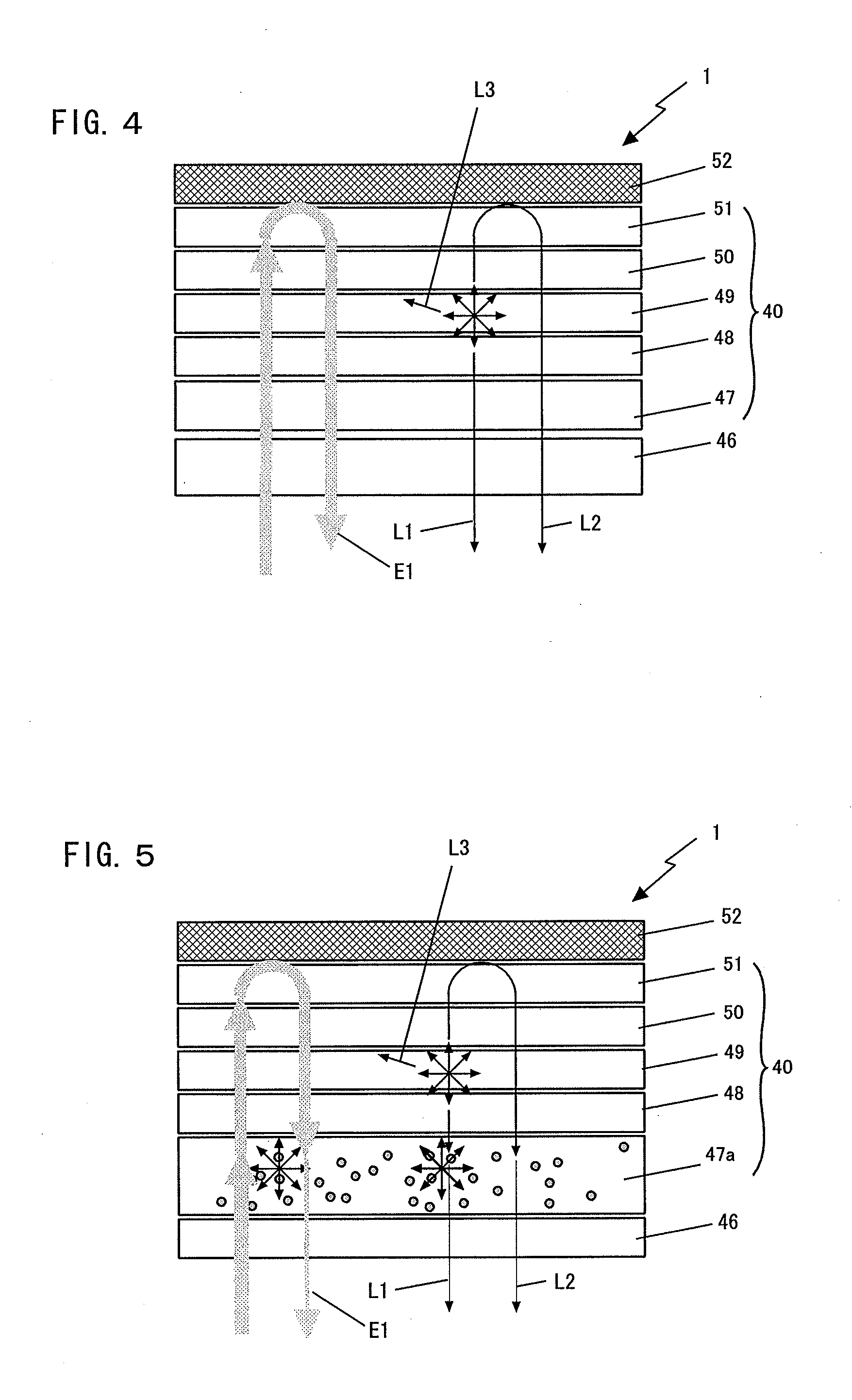Organic light-emitting device
a light-emitting device and organic technology, applied in the field of organic semiconductor devices, can solve problems such as the deterioration of contrast of the panel at a light-pla
- Summary
- Abstract
- Description
- Claims
- Application Information
AI Technical Summary
Benefits of technology
Problems solved by technology
Method used
Image
Examples
example np
[0058]FIG. 5 is a schematic image diagram showing a cross-section of an organic light-emitting device of Example NP for explaining typical optical paths. In the figure, gaps are drawn between the layers, since only the figure of being easily observed is taken into consideration. The organic light-emitting device 1 has a configuration, on the glass substrate, the transparent anode 46, the light-scattering layer 47a of the hole injection layer in which plural particles are dispersed, the hole transport layer 48, the light-emitting layer 49, the electron transport layer 50, the electron injection layer 51 and the metal cathode 52 are layered in turn. The light-scattering layer 47a is a thin film comprising a base material of the hole injection layer prepared to have a transmittance and to reflect partially light; and particles dispersed therein. The particles are, for example, metal nanoparticles of a metal such as Au, Ag or the like, or an oxide such as TiOx, ZrOx, ZnOx, MoOx, WOx, Si...
example bl
[0061]FIG. 6 is a schematic image diagram showing a cross-section of an organic light-emitting device of Example BL for explaining typical optical paths. In the figure, gaps are drawn between the layers, since only the figure of being easily observed is taken into consideration. The organic light-emitting device 1 has a configuration, on the glass substrate, the transparent anode 46, the hole injection layer 47, the semi-transparent metal layer 99, the hole transport layer 48, the light-emitting layer 49, the electron transport layer 50, the electron injection layer 51 and the metal cathode 52 are layered in turn. The semi-transparent metal layer 99 is formed between the hole injection layer 47 and the hole transport layer 48. The semi-transparent metal layer 99 may be at least one thin film prepared to have a transmittance and to reflect light partially, for example, Ag and MoO3 are contained therein. In addition, the semi-transparent metal layer 99 may be, for example, silver allo...
example bl1
[0065]FIG. 7 is a schematic image diagram showing a cross-section of an organic light-emitting device of Example BL1 for explaining typical optical paths. In the figure, gaps are drawn between the layers, since only the figure of being easily observed is taken into consideration. The organic light-emitting device 1 has a configuration, on the glass substrate, the transparent anode 46, the light-scattering layer 47a of the hole injection layer in which plural particles are dispersed, the semi-transparent metal layer 99, the hole transport layer 48, the light-emitting layer 49, the electron transport layer 50, the electron injection layer 51 and the metal cathode 52 are layered in turn. Example BL1 of the organic light-emitting device has a configuration so that the semi-transparent metal layer 99 (disposed between the light-scattering layer 47a and the hole transport layer 48) is added to FIG. 5's Example NP of the organic light-emitting device having the light-scattering layer 47a. ...
PUM
| Property | Measurement | Unit |
|---|---|---|
| Thickness | aaaaa | aaaaa |
| Thickness | aaaaa | aaaaa |
| Length | aaaaa | aaaaa |
Abstract
Description
Claims
Application Information
 Login to View More
Login to View More - R&D
- Intellectual Property
- Life Sciences
- Materials
- Tech Scout
- Unparalleled Data Quality
- Higher Quality Content
- 60% Fewer Hallucinations
Browse by: Latest US Patents, China's latest patents, Technical Efficacy Thesaurus, Application Domain, Technology Topic, Popular Technical Reports.
© 2025 PatSnap. All rights reserved.Legal|Privacy policy|Modern Slavery Act Transparency Statement|Sitemap|About US| Contact US: help@patsnap.com



